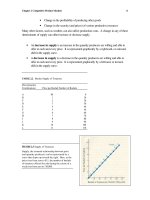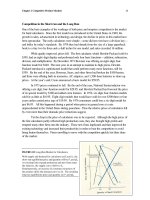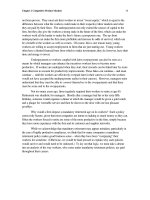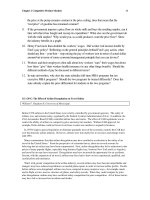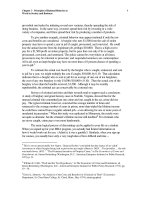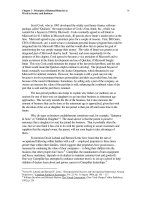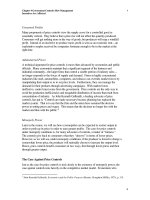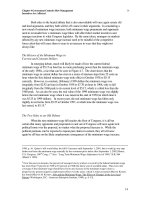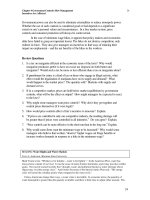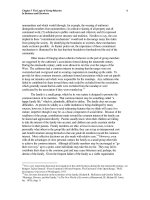Tài liệu Microeconomics for MBAs 14 pdf
Bạn đang xem bản rút gọn của tài liệu. Xem và tải ngay bản đầy đủ của tài liệu tại đây (129.88 KB, 10 trang )
Chapter 4 Government Controls: How Management
Incentives Are Affected
24
24
Government power can also be used to eliminate externalities or reduce monopoly power.
Whether the use of such controls is considered good or bad depends to a significant
extent on one’s personal values and circumstances. In a free market system, price
controls and consumer protection will always be controversial.
In the case of minimum wage hikes, it appears that policy makers and economists
alike have failed to grasp an important lesson: The hikes do not destroy competition, only
redirect its force. They also give managers an incentives to find ways of reducing their
impact on employment – and the net benefits of the hikes to the workers.
Review Questions
1. Is a tax on margarine efficient in the economic sense of the term? Why would
margarine producers prefer to have an excise tax imposed on both butter and
margarine? Would such a tax be more or less efficient than a tax on margarine alone?
2. If punishment for crime is a kind of tax on those who engage in illegal activity, what
effect would the legalization of marijuana have on its supply and demand? What
would happen to the market price? The quantity sold? Illustrate with supply and
demand curves.
3. If in a competitive market, prices are held below market equilibrium by government
controls, what will be the effect on output? How might managers be expected to react
to the laws?
4. Why might some managers want price controls? Why don’t they get together and
control prices themselves (if it were legal)?
5. How would price controls affect a firm’s incentive to innovate? Explain.
6. “If prices are controlled in only one competitive industry, the resulting shortage will
be greater than if prices were controlled in all industries.” Do you agree? Explain.
7. “Price controls can be more effective in the short run than in the long run.” Explain.
8. Why would some firms want the minimum wage to be increased? Why would some
managers who believe that workers “deserve” higher wages cut fringe benefits or
increase worker demands in response to a hike in the minimum wage?
READING: Water Rights and Water Markets
Terry L. Anderson, Montana State University
Mark Twain wrote, “Whiskey is for drinkin’—water is for fightin’.” In the American West, water has
always been a matter of survival. It was the cause of many frontier skirmishes, and it may provoke conflict
again. Newsweek warned recently that “drought, waste, and pollution threaten a water shortage whose
impact may rival the energy crisis.” And former Secretary of the Interior James Watt said, “The energy
crisis will seem like a Sunday picnic when compared to the water crisis.”
Unless Americans change their ways, a water crisis is inevitable. In economic terms, the quantity of
water demanded is greater than the quantity available, and there is little time to adjust either amount. The
Chapter 4 Government Controls: How Management
Incentives Are Affected
25
25
reason for the imbalance is that the government has been keeping prices below market-clearing levels. In
most places in the United States, water is cheaper than dirt. Nowhere in the nation do water prices reflect
the true scarcity of the resource.
In Southern California, for example, water is in short supply. Yet Los Angeles residents pay only
0.60 per thousand gallons—a quantity that costs the residents of Frankfurt, Germany, $2.80. It is not
surprising, therefore, that each person in the United States consumers an average of 180 gallons a day,
compared with 37 gallons in Germany. Water prices are actually lowest in the arid Southwest, where
residents of El Paso and Albuquerque pay $0.53 and $0.59, respectively, per thousand gallons, compared
with $1.78 in Philadelphia. In many U.S. cities the real price of water has fallen in recent decades, despite
the threat of shortages.
Agricultural users, who consume over 80 percent of the water in western states, enjoy extremely
low prices. Throughout the nation the price of irrigation water ranges from about $0.009 to $0.09 per
thousand gallons. In 1981, the average price of covering one acre of land in California’s Central Valley
with one foot of water was $5.00, or less than $0.02 per thousand gallons. Supplying that amount of water
cost the government as much as $325. According to a 1980 study by the Department of the Interior,
government subsidies covered between 57 and 97 percent of the cost of water projects.
Pricing water at market rates could help to solve the water crisis. Water consumption—whether
for industrial, municipal, or agricultural use—is highly responsive to price changes. For example, the
quantity of water used in industrial processes varies considerably around the world, depending on prices.
Where water is expensive, electric power is produced using as little 1.32 gallons per kilowatt-hour. Where
water is cheap, production requires as many as 170 gallons per kilowatt-hour. One study of urban water
consumption showed that a 10 percent increase in the price of water decreased the quantity of water
demanded about 4 to 13 percent.
Pricing water more realistically will require changes in the laws governing water use, as well as
the creation of an effective water market. Like any market, a water market will depend on well-defined,
well-enforced property rights. If water rights are secure and people can trace them, prices will quickly
come to reflect the true scarcity of the resource. During the late nineteenth century, such a system evolved
in the American West. Rights were defined on a first-come, first served basis, and institutions arose
through which owners of rights could seek out the highest and best use of the resource. The system offered
incentives that encouraged some people to deliver water wherever it was demanded. Thousands of miles of
ditches were constructed, and millions of acres blossomed, as a result of entrepreneurial efforts to deliver
water. Over time, however, legislators, bureaucrats, and judges have tinkered with the system. Legal
restrictions now limit the transfer of water, and its use is determined by politicians, not by the market.
One place where a water market might encourage more efficient water use is the Imperial
Irrigation District (IID) in Southern California. The IID receives its water from the U.S. Bureau of
Reclamation, at subsidized rates. Its water could be conserved if ditches were lined, wastewater recovered,
and the timing of irrigation changed. All those measures would be costly to farmers, however. And at
present low prices, farmers have little incentive to invest in conservation. Recently, the Municipal Water
District (MWD) of Southern California, thwarted in its effort to obtain water from Northern California, has
begun negotiating for water from the IID. The MWD is willing to fund improvements in farmers’
irrigation systems in return for the water those improvements would save. If such a trade could be
accomplished, everyone would be better off.
CHAPTER 5
The Logic of Group Behavior
In Business and Elsewhere
Men journey together with a view to particular advantage and by way of providing some
particular thing needed for the purpose of life, and similarly the political association
seems to have come together originally. . . for the sake of the general advantage it
brings.
Aristotle
1
Unless the number of individuals in a group is quite small, or unless there is coercion, . .
.rational, self-interested individuals will not act to achieve their common or group
interest. In other words, even if all. . . would gain if, as a group, they acted to achieve
their common interest or objective, they will still not voluntarily act to achieve that
common or group interest.
Mancur Olson
2
n earlier chapters, we introduced the usefulness of markets. However, as is evident
inside firms, not all human interactions are through “markets.” People often act
cooperatively in groups or, as the case may be, in “firms.” In this chapter our central
purpose is to explore how and under what conditions people can organize their behavior
into voluntary cooperative associations (groups and firms) in which all work together for
the attainment of some common objective, say, greater environmental cleanliness, the
development of a “club atmosphere,” or the maximization of firm profits. The focus of
our attention is on the viability of groups like families, cliques, communes, clubs, unions,
and professional associations and societies, as well as firms, in which individual
participation is voluntary to cohere and pursue the common interests of the members.
We consider two dominant and conflicting theories of group behavior. They are “the
common interest theory” and “the economic theory” of group behavior. The former is
based on the proposition that a group is an organic whole” identified by the “common
interest” shared by its individual members. Its basic thesis is that all groups, even very
large ones, are organized to pursue the common interest of the group members. Taking
this theory one step further, it implies that if people share a common interest, they will
organize themselves into a group and voluntarily pursue their shared interest.
According to the economic theory of group behavior, the group is a collection of
independently motivated individuals who organize voluntarily to pursue their common
interest only in small groups, like families or clubs. In large groups the common interest
1
Aristotle, Ethics, vol. 8, no. 9, p. 1160a.
2
Mancur Olson, The Logic of Collective Action: Public Goods and the Theory of Groups (Cambridge,
Mass.: Harvard University Press, 1971), p. 2
I
Chapter 5 The Logic of Group Behavior
In Business and Elsewhere
2
is very often ineffective in motivating group behavior. The logic of this theory seems
perverse; but, as we will see in later chapters, it is the basis for almost all economic
discussion of markets and explains why many policy proponents argue governments must
be delegated coercive powers to collect taxes and to pursue the “public interest.” It also
helps explain why firms are organized the way they are and why managers manage the
way they do. This is, therefore, one of the pivotal chapters in this book.
However, keep in mind that groups are not the only means by which people’s
interpersonal or social behavior is organized in society. Economics is basically a study of
comparative social systems, an examination of how the different ways of organizing
interpersonal behavior can be fitted together in different combinations. We call these
means of organizing people’s behavior “social organizers” and mention four of them
here: markets which involve exchanges of goods and services, government coercion,
violence, and voluntary groups. On the surface, violence may not appear to be a bona
fide alternative, but we are forced to mention it because of the use made of it throughout
the world. The behavior of street-gang members, for example, with respect to people
totally unassociated with them, is largely based upon either the existence or the threat of
violence. The Cold War was a tenuous truce founded to a sizable degree on the threat of
a nuclear holocaust. The persistent violence in the streets of Northern Ireland during the
1960s and 1970s will for many years have a profound influence on what the people of
that country can hope to accomplish. Many examples can be cited which illustrate the
spread of terrorist activities and the threat they represent to the fabric of social order
which has been built on the basis of other social organizers. Aside from what we have
already said with regard to anarchy, we will have little to say about violence as a social
organizer. This does not lessen the importance, which we attribute to violence; it simply
reflects the fact that economists have only recently turned their attention to the subject
and much remains to be done in the way of theory construction.
3
The question of how you appraise the roles the various social organizers should play in
social order appears to be wrapped in one’s personal ideology or value system—that is,
there appears to be no room for positive analysis. Indeed, what we as individuals want
the system to accomplish is surely a factor in how each of us evaluates potential social
organizers. Personal values will affect our attitude as to whether or not a given social
organizer should be used and, if used, how extensively. The avowed Marxist has very
harsh opinions of the market system. But perhaps just as important in our appraisal is
what we know about the relative effectiveness—the advantages and limitations—of the
potential means for ordering behavior. If, for example, we have only a rudimentary
understanding of how the market works and fail to appreciate with sufficient clarity the
limitations of cooperative efforts, we may naturally place greater reliance on voluntary
3
For example of economists’ initial probes into the area of malevolence and violence, see Kenneth E.
Boulding, The Economy of Love and Fear (Belmont, Calif.: Wadsworth Publishing Company, Inc., 1973),
and Gordon Tullock, The Social Dilemma: The Economics of War and Revolution (Blacksburg, Va.:
University Publications, 1974). Only those who wish to be challenged will find these books useful.
Chapter 5 The Logic of Group Behavior
In Business and Elsewhere
3
cooperation than we would otherwise. We, therefore, in this chapter highlight the
limitations of voluntary groups as a social organizer in order that we may appreciate why
markets are not only beneficial but also necessary in organizing a society of
heterogeneous individuals.
Common Interest Theory of Group Behavior
There are almost as many theories of group behavior as there are group theorists.
However, categorizing theories according to dominant themes or characteristics is
sensible in light of our limited space.
All theories of group behavior begin by recognizing the multiplicity of forces, which
affect group members and, therefore, groups. This is especially true of what we term the
common interest theory. Many present-day sociologists, political scientists, and
psychologists generally share this point of view, which has been prominent at least since
Aristotle. The determinants of group behavior most often singled out are the “leadership
quality” of specific group members and the need felt among group members for
“affiliation,” “security,” “recognition,” “social status,” or money. Groups like clubs or
unions form so that members can achieve or satisfy a want that they could not satisfy as
efficiently through individual action. All these considerations are instrumental in
affecting “group cohesion,” which, in turn, affects the “strength” of the group and its
ability to compete with other groups for the same objectives. From the perspective of this
theory, when people join firms, they accept the firm’s objective and pursue it because
everyone else wants the same thing, leading to self-enforcing group cohesion.
The common interest theory views the “group” as an organic whole, much like an
individual, as opposed to a collection of individuals whose separate actions appear to be
“group action.” According to the theory, the group has a life of its own which is to a
degree independent of the individuals who comprise it. Herbert Spencer, a nineteenth-
century sociologist, often described the group as a “social organism” or as a
“superorganic” entity.
4
Karl Marx wrote of the “class struggle” which will bring down
“bourgeois capitalism” and of the proletariat” which will, in its place, erect the
communist society. And it was probably the social-organism view of groups that
Aristotle had in mind when he wrote, “Man is by nature a political animal.”
5
Two major reasons are given for viewing groups as a social organism. First, a group
consists of a mass of interdependencies, which connect the individuals in the group.
Without the interdependencies, there would be only isolated individuals, and the term
group would have no meaning. Individuals are like the nodes of a spider web. The
4
Spencer was actually somewhat ambivalent on the subject; at times he also wrote of groups as a
composite of individuals. This aspect of his writing reflected the influence David Hume and Adam Smith
had on his thinking. See Herbert Spencer, Principles of Sociology (London: Williams and Norgate, Ltd.,
1896).
5
Aristotle, Politics, Book II.
